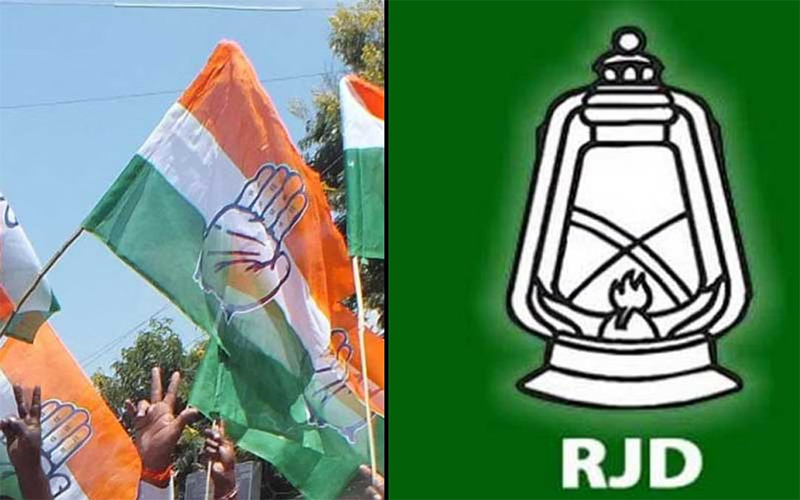By Arun Srivastava
The Congress party’s recent defeat in the Delhi assembly elections has sparked concern among its central leadership, especially considering the implications it may have for the upcoming state assembly elections in Bihar later this year. One key factor contributing to this worry is the party’s poor performance in constituencies with significant Bihari populations. This situation has prompted serious reassessment of organizational strategies in states facing imminent assembly elections.
This intent is clearly reflected in Rahul Gandhi’s approach concerning two states, Bihar and West Bengal. In Bihar, he aims to replace the current state party president, Akhilesh Singh, with a Dalit leader, an official announcement expected within two weeks. Contrastingly, in West Bengal, Rahul is urging the state party to prepare for a solo campaign.
Rahul is considering a substantial transformation in the workings of the Bihar unit. This is evident from senior Congress leader and MP Tariq Anwar’s call for clarity regarding the party’s strategies for the upcoming polls in Bihar. Senior party members note that the negative experience from the Lok Sabha elections, in which RJD chief Lalu Yadav outright rejected the Congress’s seat demands and put forward inexperienced candidates who ultimately lost, has led to skepticism about possible repeat treatment in the forthcoming assembly elections.
Not only Congress leaders, but CPI(ML) figures also believe that the INDIA alliance could have captured at least four additional Lok Sabha seats if Lalu had taken their requests seriously rather than acting unilaterally. In the 2020 assembly elections, Congress contested 70 seats but managed to win only 19, a decline of eight seats from the previous assembly. In contrast, CPI(ML) succeeded in winning 12 out of 19 seats they contested, while CPI and CPI(M) secured two seats each. Ironically, in at least three constituencies where CPI(ML) ran candidates, the RJD supported independent candidates against them.
It is alleged that the current PCC president has struggled to connect with Dalits, OBCs, EBCs, and Muslims. Notably, Anwar has stressed the urgent need for significant changes in the party’s organizational framework. “A half-hearted approach to alliances only confuses the electorate. It must be clarified whether the Congress intends to run in coalition or independently.” A common sentiment emerging in political and social circles is that some sections of intermediate and even upper castes are inclined to return to the Congress but remain skeptical. Leaders observe that the party’s state unit is predominantly influenced by Brahmins and Bhumihars, both of which align with the BJP. However, the Congress representatives from these castes cannot convincingly claim to represent them.
It is an acknowledged fact that the INDIA alliance is a fragile coalition lacking a unified voice and largely dependent on Lalu. Congress leaders note that just two months ago, Lalu supported Mamata Banerjee’s claim to lead the INDIA alliance, accusing Rahul of failing to reinforce the bloc at the national level. They believe the same criteria should apply to Bihar. Lalu and Tejashwi also need to clarify to the constituents what steps they’ve taken to fortify the alliance in Bihar. Why haven’t they conducted regular strategy meetings, being the principal partners, to effectively engage with the populace? They accuse Tejashwi of being preoccupied with rallies and yatras focused solely on bolstering his RJD.
Rahul is genuinely concerned about the ailing state unit in Bihar, and during a meeting held on February 5 to commemorate the birth anniversary of Jaglal Choudhary, a Dalit leader and Congress activist, he clearly articulated that Dalit leaders should take a proactive role in grassroots strengthening: “I envision a day when Dalits, tribals, and backward classes ascend to leadership positions, not merely serve as foot soldiers in bureaucracy and the private sector. I dream of seeing Dalits lead in every institution, just as Baba Saheb Ambedkar and the Dalit icon of Bihar, Jaglal Choudhary, envisioned.”
His message is clear; “While the Delhi assembly elections are taking place, I deemed this event equally significant. Hence, I traveled here right after casting my vote,” expressed the 54-year-old leader. During a 30-minute address, Gandhi extensively discussed the necessity for greater “bhagidaari” (participation) of Dalits, tribals, and OBCs in all sectors, asserting that mere political representation is insufficient. Without this, Dalits and other marginalized groups can only hope for an improved existence. The BJP-RSS understands this, which is why they subtly undermine the Constitution.”
Nonetheless, there are expectations that a reorganized Congress, under its new state president, will strive to formulate an electoral plan in collaboration with its allies in the Mahagathbandhan. Echoing Rahul’s sentiments, the state Congress plans to advocate for a new caste survey, believing that the previous one conducted by the BJP-led NDA fell significantly short.
State Congress leaders are not opposed to the party’s independent run in the Delhi elections. They commend the leadership for making a deliberate effort to rebuild the party from the ground up. As a national party, Congress must embrace risks to re-establish its presence. Many leaders feel that, regardless of the electoral results, the party should consider running alone in Bihar as well, which could help to reconnect with the electorate and encourage its foundational supporters to return. These leaders are also open to collaborating with the Left coalition, recalling CPI’s previous partnership with the Congress in Bihar.
In light of the current political climate, sources indicate that the RJD is also contemplating a more adaptable approach toward their partners in the INDIA alliance. RJD state general secretary Shashwat Gautam expressed, “The alliance between Congress and RJD is longstanding and well-tested. RJD has been Congress’s closest ally during tough times, and Laluji historically remarked that Sonia Gandhi is a respected bahu (daughter-in-law) of India. The Bihar elections are crucial, and both parties are aware of this, and discussions about alliances will be framed by this understanding. Tejashwi Prasad, the Leader of the Opposition, and Congress leader Rahul Gandhi are well-equipped to discuss and resolve all alliance-related matters for Bihar. What happens in Delhi is a thing of the past.”
If Congress leaders can be believed, Rahul intends to contest all available seats in both Bihar and Bengal, expressing optimism about winning back former workers and supporters who have distanced themselves from active political life. They argue that several BJP leaders and activists previously aligned with Congress. In Bengal, the conditions appear more favorable for Congress. While there are worries about the party’s performance in the 2026 assembly elections, there is confidence that it could rejuvenate its workforce, which would be vital for Congress’s chances in the next Lok Sabha elections in 2029.
These party insiders caution, however, that while this strategy may not yield significant electoral gains immediately, it marks an essential first step. They stress that the national leadership has kept channels open with Mamata Banerjee, but it is her responsibility to reciprocate as a trusted ally. However, they are mindful of Mamata’s recent assertion: “There is no question of an alliance. The Trinamool will run independently and achieve a historic win. The Congress has no meaningful presence in Bengal. We don’t require an alliance with Congress in Bengal.”
Yet, RJD’s Manoj Kumar Jha views the AAP’s defeat as a sign of the public’s desire for change. He asserts that in Bihar, the unity of the INDIA bloc under RJD will face significant scrutiny. Instead of engaging in blame-shifting, Jha advocates for a more objective assessment of the situations arising from Delhi’s outcome. “Even the Congress can express grievances regarding AAP’s competition in Goa, Gujarat, Haryana… Such dynamics are integral to broader democratic processes… However, the essence of the INDIA bloc was established at the national level to present a viable alternative to the BJP. This goal remains pertinent. All parties involved must convene and strategize for the future.” (IPA Service)


Leave a Reply